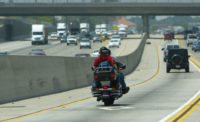NTSB: A watchman’s warning not enough to prevent train accidents
2 workers killed by a train in SD

The National Transportation Safety Board (NTSB) today issued a Safety Alert warning rail workers of the risks of working on the tracks using only a watchman/lookout to provide the train approach warning.
Two workers struck, killed by train
Safety Alert 066 was prompted in part by the deaths of two rail workers who were struck and killed by a train in Edgemont, South Dakota, Jan. 17, 2017. The NTSB investigation found the sight distance used by the watchman/lookout was about half the distance required by federal regulations. The Federal Railroad Administration requires that workers be able to clear the tracks at least 15 seconds before a train moving at the maximum authorized speed can pass the work location safely.
“The accident cited in this safety alert, and other recent similar accidents, warrant a reminder to railroad employees to remain vigilant for approaching trains – whether they are the watchman/lookout or whether they are working on the tracks,” said NTSB Acting Chairman Robert L. Sumwalt. “If a watchman/lookout does not devote his or her full attention to their duty of looking for approaching trains, they might not provide warning of an approaching train with sufficient time for their coworkers to clear the tracks. This alert highlights actions that when followed, will save lives railroad worker lives.’’
Docket opened
The NTSB Thursday also opened the docket for the Edgemont investigation. The public docket contains only factual information collected by NTSB investigators, and does not provide analysis, findings, recommendations or probable cause determinations. No conclusions about how or why an accident or incident occurred should be drawn from information contained within the docket. Opening the docket affords those with a need and desire for its contents the opportunity review what factual information has been gathered about the accident. Any analysis, findings, recommendations, or probable cause determinations related to the accident will be issued by the NTSB at a later date.
Railroad worker safety was previously addressed by the NTSB in its Special Investigation Report on Railroad and Rail Transit Roadway Worker Protection.
Looking for a reprint of this article?
From high-res PDFs to custom plaques, order your copy today!








